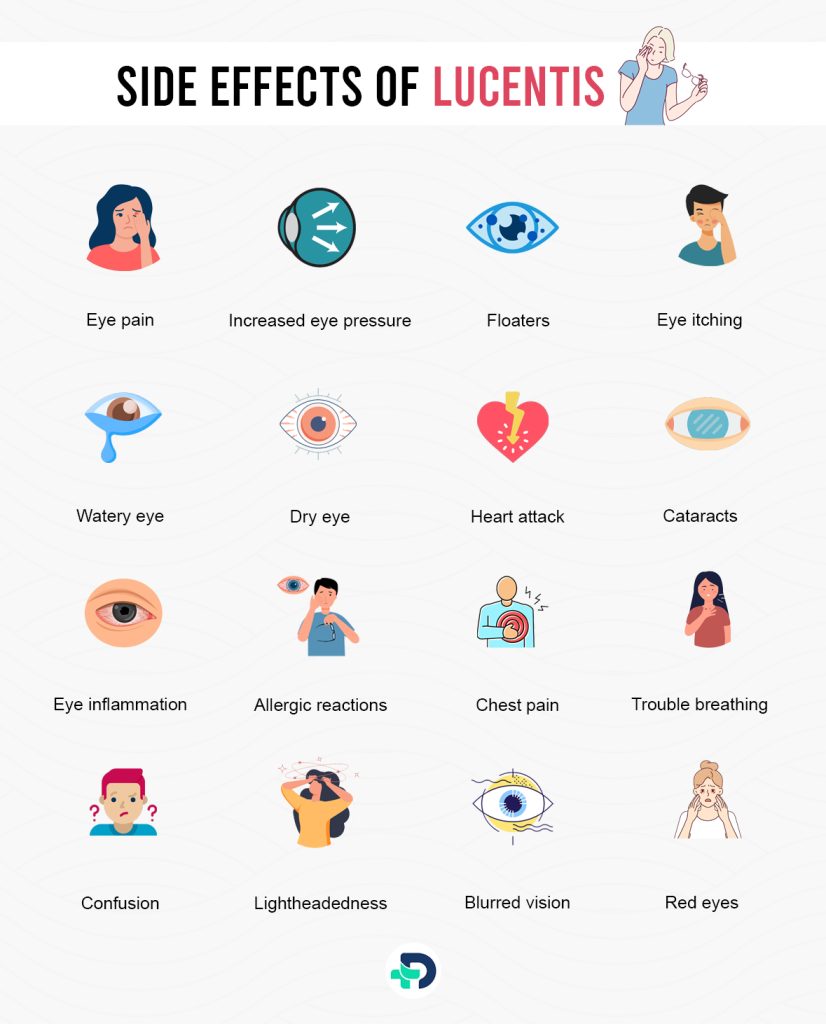Lucentis: Uses, Side Effects, and Precautions

- Lucentis
- 05 Sep 2023
Introduction
What is Lucentis?
Lucentis is the trade name for the prescription drug to treat certain eye conditions in adults viz; diabetic retinopathy, wet age-related macular degeneration, myopic choroidal neovascularization, diabetic macular edema, and macular edema. Lucentis drug comes in liquid form that doctors give as an injection into the eye. The drug does not cure the disease but only slows the disease’s progression and vision loss. An ophthalmologist (eye doctor) might also use Lucentis injection for other retinal conditions not listed above.

Here are some facts about Lucentis
- Lucentis is a biologic medication that is also available in its biosimilar form.
- Pharmaceutical companies make biological medication from living organisms. Biosimilar form of natural medicines contains some similarity with the biological drug but not the exact version of the biological drug, unlike generic drugs with the same copy of the trade name drug.
- The other trade names of active drugs in Lucentis are Cimerli, Susvimo, and Byooviz.1Introduction | Researched based study from National institutes of Health
Mechanism of Action
How does Lucentis work?
- Lucentis contains ranibizumab as the working component. Ranibizumab is from the drug class called vascular endothelial growth factor inhibitors.
- A drug class is a cluster of drugs that functions the same [2].
- Some eye diseases occur due to the growth of unusual blood vessels in the back of our eyes (retina). It can cause fluid buildup with gradual vision impairment and total vision loss.
- For the unusual blood vessels to grow, they need the body’s natural substance called vascular endothelial growth factor.
- Lucentis works by affixing to vascular endothelial growth factor, inhibiting new blood vessel growth. It results in decreased fluid accumulation in the eye and better vision with time. 3Mechanism of Action | Researched based study from National Institutes of Health
Dosage
Dosage
The Lucentis injection dose and frequency will depend on certain conditions, viz, the severity of the illness and the patient’s response to the drug
Some of the commonly prescribed dosage for Lucentis injections are as follows-
Dosage for Diabetic Retinopathy
- 0.3 mg (milligram) in 0.05 mL (milliliter) solution at an interval of 28 days
Dosage for Wet age-related Macular Degeneration
- General dose- 0.5 mg (milligram) in 0.05 mL (milliliter) solution at every 28 days interval
- Doses (in some cases) – a changed dose every 60 days or 90 days
Dosage for Macular Edema (due to retinal vein blockage)
- 0.5 mg(milligram) in 0.05 mL(milliliter) for 28 days
Dosage for diabetic Macular Edema
- 0.3 mg(milligram) in 0.05 mL(milliliter) solution for 28 days
Dosage for Myopic Choroidal Neovascularization
- 0.5 mg(milligram) in 0.05 mL(milliliter) solution at 28 days interval for 90 days .4Dosage | Researched based study from Science Direct .
Uses
Uses of Lucentis
Lucentis is FDA-approved to manage the following eye diseases –
Neovascular age-related macular degeneration or wet age-related Macular Degeneration
- It is a progressive eye disease that occurs when unusual blood vessels develop in the eye’s macular region leading to the leaking of blood and fluid in the area.
- Macula is the area in the retina’s central portion.
- It causes significant vision problems followed by complete vision loss if left untreated.
Myopic Choroidal Neovascularization
- It is a condition in people with severe myopia (shortsightedness).
- Left untreated, it can lead to an abrupt or gradual decline in central vision.
- Myopic choroidal neovascularization occurs due to the development of new, unusual blood vessels in the retinal region.
Macular edema after blockage of Retinal Vein
- It happens when a blood clot clogs the eye’s blood flow from the eye, causing fluid and blood to drip into the eye’s macular region.
- If left untreated, macular edema can lead to vision issues and even blindness.
Diabetic Macular Edema
- It is a diabetic complication that creates retinal swelling due to fluid accumulation in the retina’s macular region.
- It can consequently lead to complete vision loss.
Diabetic Retinopathy
- It is a complication of persistent high sugar in the body that destroys the retinal blood vessels.
- The prolonged increased sugar level in the body causes imbalances in the entire body, including the eye.
- The body excessively produces a vascular endothelial growth factor in the eye that helps create new blood vessels.
- Consequently, new blood vessels cause fluid accumulation in the posterior portion of the eye (retina), leading to a decline in vision and, eventually, blindness.
- Lucentis work by attaching to a body’s natural compound called vascular endothelial growth factor required for new blood vessel generation. Thus, it helps prevent new blood vessel formation and further fluid accumulation within the eye, improving an individual’s vision with time.5Uses | Researched based study from Science Direct
Side Effects

Lucentis Side Effects
Common side effects
- Eye pain
- Bleeding within the eyes
- Increased eye pressure
- Floaters (tiny shapes floating in the field of vision)
Mild side effects
- Eye itching
- Watery eye
- Dry eye
- Unclear vision
- Eye pain
- Bleeding within the eye’s sclera (white of eyes)
- Floaters
- Eye discomfort
Serious side effects may include
- Blood clots causing heart attack
- Cataracts
- Anemia
- Eye inflammation
- Retinal detachment
- Allergic reactions
Blood clots causing heart attack
Symptoms
- Chest pain
- Trouble breathing
- Discomfort in eyes, neck, and arms
- Confusion
- Lightheadedness
Cataract (clouding of the eye’s lens)
Symptoms
- Double vision in one eye
- Blurred vision
- Sensitivity in seeing the light
- Difficulty in night vision
Anemia (lack of healthy Red blood cells )
Symptoms
- Increased tiredness
- Lightheadedness
- Weakness
- Abnormal heartbeat
- Tightening of the chest with pain
- Weakness
Eye inflammation (Endophthalmitis)
Symptoms
- Unclear vision
- Swollen eyes
- Red eyes
- Eye pain
- Difficulty seeing the bright light
Retinal detachment (separation of light-sensitive tissue from the back of the eye)
Symptoms
- Unclear vision
- Floaters
- Decreased side vision
- Light flashes in front of the eyes
Allergic reaction
Symptoms
- Eye redness,
- Low vision,
- Eye itching,
- Eye swelling
- Difficult breathing.6Side Effects | Researched based study from National Institutes of Health
Formulations
Available Formulations
Lucentis is available as a fluid in vials or prefilled syringes. It comes in two powers (strength) –
- 0.3 mg (milligrams) in 0.05 mL (milliliters) solution
- 0.5 mg in 0.05 mL (milliliters) solution.7Formulations | Researched based study from National Institutes of Health
Administration
How is Lucentis given?
Ophthalmologists give Lucentis injections directly as an injection into the eye at a doctor’s clinic or hospital.
Before giving the injection, the eye doctor might do the following things-
- Clean the eye with an antiseptic to avert infections
- Give drugs viz; eye gels or injections to numb the eye and prevent pain
- An eye medication that dilates the eye’s pupil
- Then the doctor will inject a fine needle into the eye’s sclera (white part of the eye) to deliver the Lucentis medication.
Depending on the patient’s need, the doctor might advise the patient to take the Lucentis injection for several months.8Administration| Researched based study from National Institutes of Health
Missed dose
- The Lucentis injections are delivered at the doctor’s office by an Ophthalmologist. So, the office will give appointments at the patient’s convenience.
- However, to ensure the appointment for the dose of Lucentis injections, try setting the reminder app on your mobile.
Overdose toxicity of Lucentis
- In case of an incidental overdose of Lucentis injections followed by trouble breathing, one must immediately dial the poison control center or emergency medical number based on the location.
Precautions
Precautions
- Pregnancy – There is insufficient information if Lucentis is safe during pregnancy. If one is pregnant or planning to start a family, always consult the doctor before taking the Lucentis injection.
- Nursing mothers – It is also unclear if Lucentis passes to breast milk, so nursing mothers must speak to the doctor before taking the Lucentis treatment.9Precautions | Researched based study from National Institutes of Health
Considerations
Considerations before taking Lucentis
Lucentis might not be appropriate for people with the following health issues-
- Allergic to ranibizumab or any other drug
- Glaucoma (increased eye pressure)
- Eye infection
- Prior eye surgery
- Pregnant woman
- Nursing mothers.6Considerations | Researched based study from National Institutes of Health
Interactions
Drug Interactions with Lucentis
- There is no relevant information on whether Lucentis can interact with other medications. However, there is every possibility that Lucentis can interact with other medicines, vaccines, herbs, drugs, or supplements. So, tell your doctor about all the medications that you are taking before getting the Lucentis injection to avoid probable interactions.10Interactions | Researched based study from National Institutes of Health
Storage
How to Store Lucentis?
- One can store Lucentis in the refrigerator between 2 to 8 degrees centigrade.
- One should avoid freezing Lucentis or keeping it under direct sunlight
Key Takeaways
Key Takeaways
- Lucentis is an FDA-approved eye injection for managing certain eye conditions in adults, such as wet age-related macular degeneration, myopic choroidal neovascularization, macular edema, diabetic macular edema, and diabetic retinopathy,
- One can take Lucentis eye injection at a hospital or doctor’s clinic
- Individuals with medical ailments must speak to the ophthalmologist before taking Lucentis injections to avert unwanted complexities.
Any feedback on this article?
 This Articles content was accurate
This Articles content was accurate Very Informative Article
Very Informative Article I have a question or a comment
I have a question or a comment
 This article contains inaccurate content
This article contains inaccurate content This article was not helpful
This article was not helpful I have a question or a comment
I have a question or a comment
We appreciate your helpful feedback!
Checkout our social pages
References
-
National Institutes of Health
Introduction
-
Science Direct
Mechanism of Action
-
National Institutes of Health
Mechanism of Action
-
Science Direct
Dosage
-
Science Direct
Uses
-
National Institutes of Health
Side Effects | Considerations
-
National Institutes of Health
Formulations
-
National Institutes of Health
Administration
-
National Institutes of Health
Precautions
-
National Institutes of Health
Interactions






































